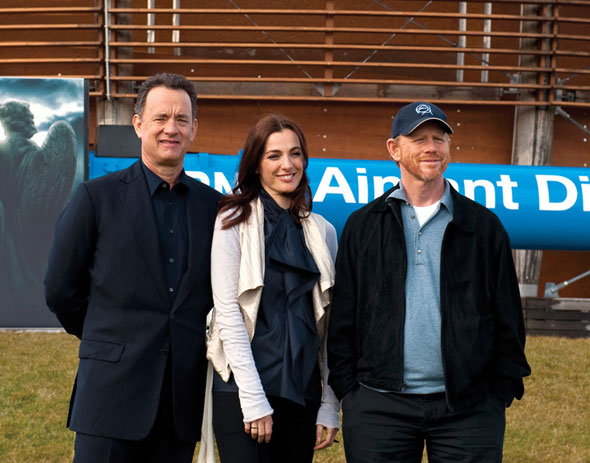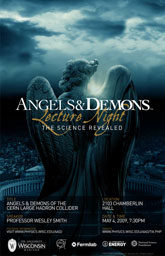Physics lessons from Angels & Demons
 |
| Tom Hanks, Ayelet Zurer and Ron Howard at CERN to promote the movie Angels & Demons. Photo: CERN |
Reyna Pratt spends her days preparing high school students in Virginia for an increasingly competitive world. They learn biology, algebra, English composition, world history, and world cultures.
“I would love to teach my students about nuclear and particle physics,” says Pratt, a former theoretical nuclear physicist. “There's just no time in the curriculum and schedule.”
Now, thanks to Angels & Demons, the big-screen adaptation of Dan Brown's best-selling novel, her students and many others will get a glimpse at those scientific worlds, wrapped in Hollywood glitz and action.
 |
The private girls' school where she teaches is one of about 50 locations in the United States, 10 in Canada, and several in Europe and Asia scheduled to offer lectures explaining the science behind the film, its factual inaccuracies, and what high-energy physics research can do for the world.
“When I saw this opportunity,” Pratt says, “I snagged it!”
The film, which stars Tom Hanks, is a detective story about an ancient secret society that tries to destroy the Vatican with a bomb made of antimatter stolen from a particle physics laboratory. Parts of the movie were filmed at CERN's Large Hadron Collider, the world's largest and most complex scientific venture.
In reality, antimatter would be useless as a bomb or energy source; it's too hard to produce and store. The book misrepresents the production and storage of antimatter at CERN and portrays the European laboratory as more opulent than it really is.
Nonetheless, dozens of scientists are seizing on the film as a way to convey the truth about particle physics, using lecture materials prepared by CERN and Fermilab—the only other place in the world that produces and stores significant numbers of antimatter particles.
One of those volunteer lecturers is David Goldstein, a physicist studying acoustics at the Naval Research Laboratory.
“If I can contribute to inspiring someone,” he says, “or clear up some misunderstanding, or answer some questions in a way that someone might not otherwise have access to, then so much the better.”
Find lectures near your town at www.uslhc.us/Angels_Demons.
Tona Kunz
Click here to download the pdf version of this article.






